electronics-journal.com
26
'21
Written on Modified on
How Ultra-Low-Power Sensor Solutions are Enabling Smart and Secure Connected Buildings
The infrastructure to support the Internet of Things (IoT) is now well established, extending far beyond the unseen legions of servers and data centers to reach right into our homes, offices and factories.
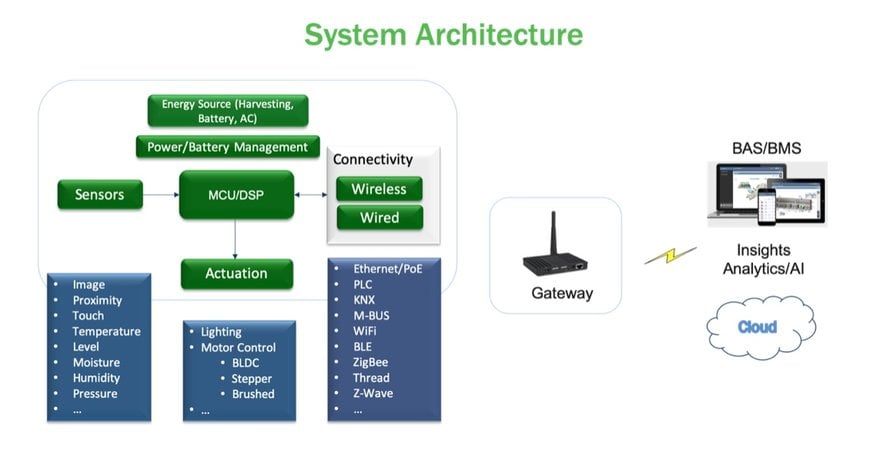
By: (Pavan Mulabagal, Director, IoT Strategy and Marketing, ON Semiconductor).
Sitting at the edge are sensors, gathering data and relaying it back to cloud services, or processing it locally, in an actionable way. These sensors are integral to making buildings smarter, providing a hands-off approach to controlling our environment. The primary drivers for this are convenience and economics; an autonomous building never forgets to turn the lights off when the last person leaves the room.
What started as a relatively simple control system, using occupancy detection and temperature measurement to set heating and lighting levels, for example, has developed in its sophistication. Just as the buildings are becoming smarter from the user’s perspective, the systems that enable that are also becoming smarter.
The use of Artificial Intelligence (AI) will ultimately remove the need for a person to program the schedule for a smart building. Simple sensors that detect general occupancy in a large area will be displaced by more sophisticated image sensors that can recognize individuals and provide control in a more personal way. The anonymous motion detector will make way for imaging systems that can recognize individual faces, as well as gestures and even moods. Audio control, implemented through smart speakers or virtual assistants, is another important feature growing rapidly in popularity.
As buildings become smarter, their capabilities will expand to provide a more personalized experience that includes access control and other security features. This extends beyond energy optimization by turning lights off when a room is empty, to include only allowing authorized people into the room, automatically clearing individuals for access to secure networks when inside, and even helping locate items.
Smart buildings will lead to intelligent energy
Today, two aspects of facility management represent around 40% of energy consumption- lighting and heating. The concept of using occupancy detection and ambient light levels to adjust artificial lighting levels outdates the internet. Despite this long heritage, the adoption of connected lighting is in the ascendency and is entirely enabled by technologies that now underpin and advance the IoT.
One key element in this is communication. The advent of wireless mesh networking has made it much simpler and more reliable to connect smart lighting fittings together. Continued advancements in Power over Ethernet (PoE) technology, coupled with the extreme power savings delivered though LED technology, means lighting can now be powered and connected using a single low voltage Ethernet cable, removing the need for an electrician to be employed to install connected lighting.
Now, these connected terminals that were just light fittings become so much more. They form an integral part of the smart building network, as each light fitting can effectively act as a beacon for indoor navigation, for example. It also becomes much simpler to include additional functionality to light fixtures, such as occupancy detection, asset tracking, environmental monitoring. All of these features are enabled by multiple sensors that can now be integrated into a single, connected device.
It will be developments like this that will enable buildings to offer more convenience for the occupants, of course, but ultimately the biggest gain will be in the energy they can save by operating in a smarter way.
Building smarter buildings
The topology of a smart building system will depend on sensors and actuators, as described and shown in Figure 1.
The microcontroller or Digital Signal Processor (DSP) at the heart of the system will be responsible for orchestrating the numerous sensors and actuators present. This will include those used in occupancy detection, environmental monitoring and access control, while the actuators present may include brushed or brushless DC motors to open and close doors and windows, in addition to the electromechanical or solid-state relays used to turn lights on and off. Variable light levels will be achieved using some form of power modulation, such as PWM, and the MCU/DSP may well be responsible for this. Connectivity will be a combination of wired and wireless, in this respect there is a growing number of protocols that might be used, some which support the same protocols used by the internet and so are accessible directly, others that will require a gateway.
We are also now entering the realms of ultra-low-power systems, where the MCU, sensors and actuators can conceivably all be powered through energy harvested from the environment, such as light or heat. This creates the potential for virtually self-sustaining control systems.
Important factors to consider when developing the communications network behind a smart building infrastructure include range, power and latency. The weight given to each of these factors will depend on the actual application, however any noticeable latency between walking into a darkened room and the lights coming on will be eminently noticeable for occupants; just one example of why low latency is important.
In general, local processing will deliver lower latency than relying solely on cloud processing resources to make local decisions. If a sensor is able to decide for itself when someone entering a room warrants the light levels being increased, it will produce an overall better user experience.
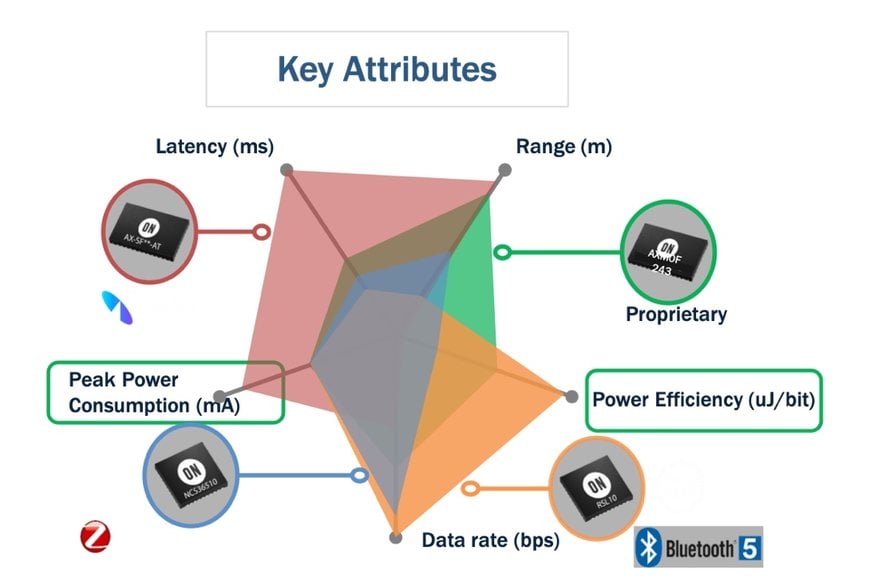
The main factors to consider when developing a smart building communication infrastructure
Figure 2 illustrates how these factors can influence the choice in wired/wireless technology. By implementing simple but robust mesh networking (Figure 3), it is possible to build small networks of connected devices that includes light fixtures, fans and other assets. Mesh networking not only provides a way of extending a network far beyond the reach of a single node, it also builds redundancy into the network, allowing messages to pass through the network using any combination of connected nodes. This means that if local interference obstructs a message from using one light fitting as a waypoint, the network will automatically reroute it. Most modern wireless protocols now employ mesh networking for this reason.
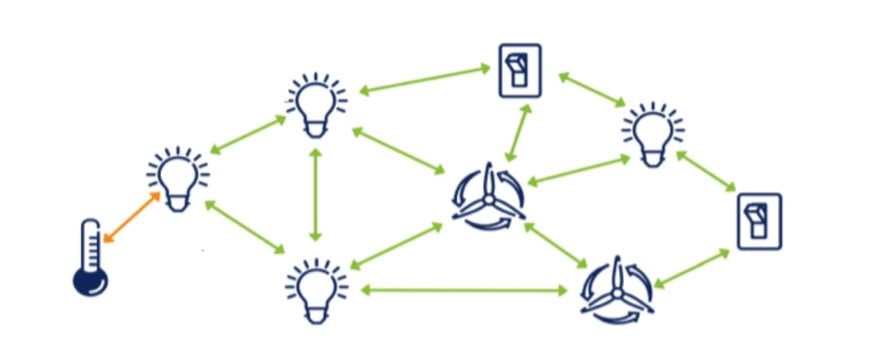
Mesh networking extends a network and provides routing redundancy
Multi-sensor platforms deliver more
As technology improves, it is becoming more feasible to integrate multiple sensors into a single platform, creating greater value for connected assets, particularly where the main value is defined by its primary function. Take a light fixture as an example. Its primary function is to illuminate, but as discussed it also represents an almost ideal sensor node for capturing a vast array of data.
By putting multiple sensors into a single asset, that asset’s value increases immensely. It becomes a critical part of the smart building infrastructure, yet outwardly looks and behaves like a regular light fixture. The physically small and ultra-low-power nature of sensors means a small outline PCB can easily accommodate multiple sensors to monitor occupancy, temperature, humidity, air quality and more. Using an ultra-low-power communications device like the RSL10 Bluetooth® Low Energy radio allows this multi-sensor platform to run for years from a single coin-cell battery (Figure 4).
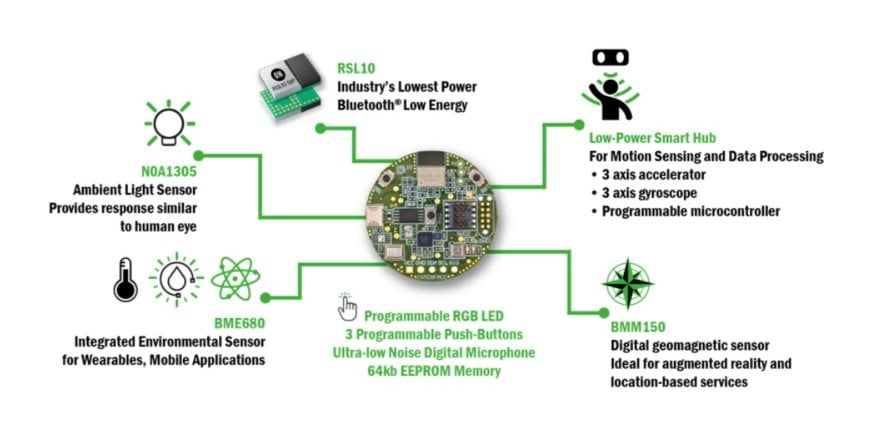
An example of a multi-sensor platform, enabled by the RSL10 System in Package (RSL10 SIP)
Furthermore, it is now even possible to remove the need for a battery altogether and use energy harvested from the environment to power multi-sensor, connected platforms (Figure 5).
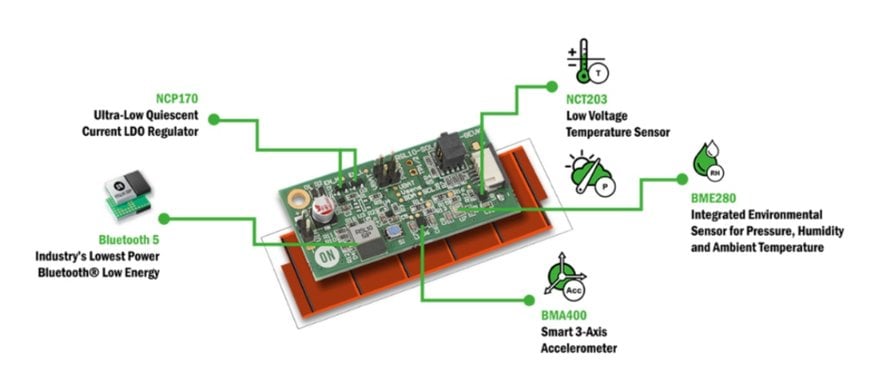
Energy harvesting technologies can now provide the primary source of energy for smart sensors and actuators
This allows smart sensors to be placed virtually anywhere in a building. For example, relatively small and unobtrusive solar cells could be used to harvest enough energy from artificial lighting to power a multi-sensor platform, sending data back to a gateway on a regular basis.
Conclusion
Energy efficiency is going to be fundamental to the continued success of smart buildings, both in terms of making buildings more energy efficient to achieve lower power consumption, and in delivering low power solutions with advanced technologies that can make that possible.
Throughout the entire technology stack, energy conservation will be key, that means from the sensors used all the way up to the cloud services being accessed. As the number of sensors deployed grows, the granularity with which we can apply control over a building’s utilities also increases, promoting a circle of energy efficiency.
However, this relies heavily on the continued efficiency improvements in sensor, processor, and connectivity technologies. As volumes increase, it may even become necessary to employ technologies that have energy independence, using energy harvesting techniques to generate their own supply.
ON Semiconductor is pioneering the development of ultra-low-power sensing and connectivity technologies such as its highly integrated Bluetooth 5 solution, the RSL10. Complemented by intelligent audio processing and imaging systems, ON Semiconductor stands committed to delivering higher energy efficiency and smarter solutions.
www.onsemi.com

